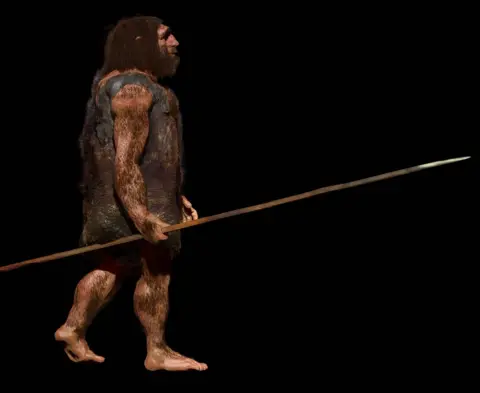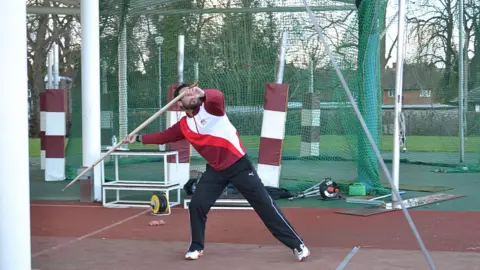Neanderthals 'could kill at a distance'
 JOHN BAVARO FINE ART/SCIENCE PHOTO LIBRARY
JOHN BAVARO FINE ART/SCIENCE PHOTO LIBRARYNeanderthals may once have been considered to be our inferior, brutish cousins, but a new study is the latest to suggest they were smarter than we thought - especially when it came to hunting.
The research found that the now extinct species were creating weaponry advanced enough to kill at a distance.
Scientists believe they crafted spears that could strike from up to 20m away.
Lead researcher Dr Annemieke Milks, from UCL Institute of Archaeology, said: "The original idea was that Neanderthals would have been very limited using hand-delivered spears, where they could only come up at close contact and thrust them into prey.
"But if they could throw them from 15m to 20m, this really opens up a wider range of hunting strategies that Neanderthals would have been able to use."
 P. Pfarr NLD
P. Pfarr NLDThe researchers looked at wooden spears that were excavated in Schöningen in Germany in the 1990s.
Made from spruce, they are estimated to be around 300,000 years old and were discovered along with thousands of bone fragments.
The team tested the performance of these weapons by creating replicas - and then handed them to javelin athletes who attempted to hit a target from a range of distances.
"Javelin athletes are definitely not a perfect proxy for Neanderthals," admitted Dr Milks.
"But previously we relied on unskilled people to thrust or throw these weapons in experimental work, so our ideas about how they functioned are based on unskilled use."
It had been thought that the spears, weighing 760-800g, were too heavy to travel at significant speed with enough accuracy to be used as long-distance weapons.
 Annemieke Milks
Annemieke MilksBut the team found that the athletes could hurl the replicas to accurately reach a target up to 20m away.
"The distances are much more than is currently suggested, but also they impacted with significant energy, enough to kill large prey," said Dr Milks.
"This really opens up the Neanderthal behavioural repertoire of hunting. We're having more and more evidence of just how clever Neanderthals were," she added.
The study is the latest to suggest our original view of Neanderthals as hulking, dim-witted cousins has done them a disservice.
In addition to being able to craft weapons, they could also construct and use tools - and even built objects on a larger scale, such as mysterious stone rings found underground in France.
Other archaeological evidence shows that some Neanderthals looked after their sick and buried their dead, while a recent paper suggested they could also turn their hand to art - with the discovery of cave paintings in three sites in Spain.
They also bred with humans - leaving a legacy of a small amount of their DNA in present-day Europeans, Asians and Oceanians.
Commenting on the research, Clive Finlayson, director, chief scientist and curator of Gibraltar Museum, said: " I'm not surprised that early humans from 300,000 years ago had this kind of ability.
"Humans have been intelligent for a lot longer than we have given them credit for and the whole idea of a cognitive revolution that applied exclusively to our own ancestors, and leading to the replacement of all other humans from the planet, is defunct."
But he added: "I'm not certain why the spears are now attributed to Neanderthals.
"They may have been made by them or indeed their ancestors (normally assigned to Homo heidelbergensis) and chronology alone should not be used to assign human taxon.
"It does not negate, all the same, the early abilities of these people."
Follow Rebecca on Twitter.
